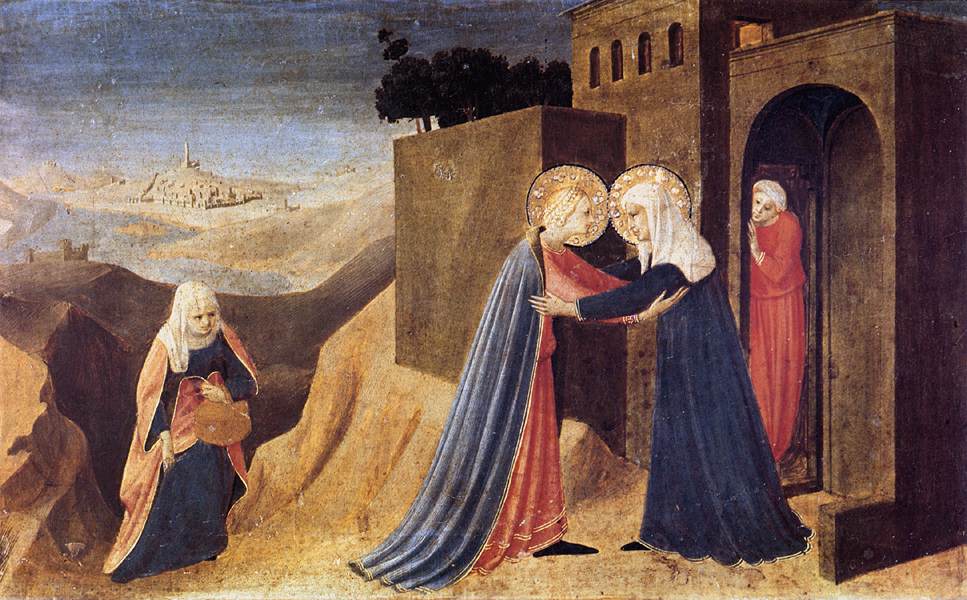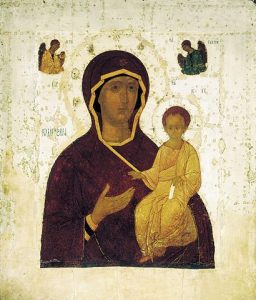
On the fourth Sunday of Advent the lectionary Gospel finally brings us to what we thought the whole of Advent should be about: the anticipation of the birth of Jesus. No more of John the Baptist and his wild preaching about turning the world upside down, leveling the mountains and filling up the valleys with the rubble.
Or maybe the distinction is not so clear.
Luke 1:39-55
Maybe this encounter between Mary, newly pregnant with Jesus, and her aged cousin Elizabeth, six months along with John, is just another testimony to the radical changes Jesus intends.
The lectionary specifies only Luke 1:39-45, which is Mary and Elizabeth’s moment of greeting. The longer section, Luke 1:46-55, is optional — but it continues the same scene, taking us through Mary’s great song of praise. I can’t leave that behind.
Four Radical Reversals
If I am lulled into sleep this Advent expecting tidings of comfort and joy, Luke 1:39-55 should effectively bring me out of it. Everything going on in this passage goes against my expectations as a Christian in 21st century North America.
1. Elizabeth’s Greeting
If I’m a typical Protestant, Elizabeth’s greeting to Mary rocks my sensibilities.
Blessed are you among women, and blessed is the fruit of your womb.” (Luke 1:42 NRSV)
It is Elizabeth’s greeting, but it comes with divine authority: not only is it in Scripture but Luke points out that she spoke because she “was filled with the Holy Spirit” (Luke 1:41 NRSV).
Why would that be shocking?
Well for one thing a lot of Protestants don’t much like to talk about Mary. We tend to think talking about Mary is a Catholic thing. And a whole lot of Protestants run away screaming from anything that is “too Catholic.”
Catholic Christians call her “the Blessed Virgin Mary,” and we don’t much like it — but here is Elizabeth, through the Spirit, calling her “blessed.”
Actually most Catholics will find this greeting extremely familiar. Along with the Angel Gabriel’s greeting to Mary from Luke 1:28 it makes up the majority of the “Hail Mary” prayer repeated in the Rosary:
Hail Mary, full of grace, the Lord is with thee. Blessed art thou amongst women, and blessed is the fruit of thy womb, Jesus.”
Many of us Protestants are very into memorizing Scripture and using Scripture in prayer. But we are so afraid of wrongly worshiping Mary that we just don’t want to memorize and pray these particular verses.
But Mary herself is about to proclaim that
from now on all generations will call me blessed,” (Luke 1:48 NRSV).
So maybe we Protestants just need to get over ourselves.
What if having a really Biblical Advent meant developing a more positive relationship with Mary — and becoming open to Christians of other traditions who love her?
2. John’s Recognition
Then for many, if not most, Protestants in North America John the Baptist’s action in this text is a shocker.
John, a six-month old fetus, is said to recognize Jesus, a newly conceived fetus, when pregnant Mary came near to pregnant Elizabeth.
We tend to think of this as a sort of whimsical poetic flourish, but what if it we took it to be true?
Some might find their views of the beginnings of human life challenged by this.
What might be the implications if a child in utero is actually sentient? Capable of recognizing someone and responding emotionally or rationally?
Others might find it challenges their views on infant baptism
The larger group of Protestants in America that this text might shock are those in the Baptist or Anabaptist traditions, and the many non-denominational evangelicals influenced by them.
Why? Because, as Martin Luther pointed out centuries ago, this passage removes one of the crucial objections people raise to infant baptism.
A couple pastors had written to Luther with their concern that baptism of infants was illegitimate. They thought personal faith was a requirement for baptism — and how could an infant have faith? Luther notes that John’s response to Jesus indicates faith — not just as an infant, but in utero.
Here’s a chunk of Luther’s reply:
Who has made you so sure that baptized children do not believe in the face of what I here prove that they can believe? … What if all children in baptism not only were able to believe but believed as well as John in his mother’s womb? We can hardly deny that the same Christ is present at baptism … who in those days came in his mother’s womb to John. …Since then he is present, speaks, and baptizes, why should not his Word and baptism call forth spirit and faith in the child as then it produced faith in John?*
A whole lot of Christian denominations don’t believe in infant baptism. When I was a seminary professor I regularly had to counsel with Presbyterians and Methodists who were up for ordination but honestly personally didn’t believe in infant baptism. What would they do?
I usually had them read Luther about John. (If you want to read it in context, here’s the book on Amazon.)
What if having a really Biblical Advent meant becoming open to infant Baptism — and to those Christians of other traditions who practice it?
3. Mary’s Self-Identification
Were I Catholic or Orthodox I might find myself a bit upended by pondering Mary’s own assertions about herself:
…my spirit rejoices in God my Savior, for he has looked with favor on the lowliness of his servant.” (Luke 1:47-48 NRSV)
This is Mary’s contribution to the biblical teaching thus far on who she was and why she was chosen. Earlier in the chapter Luke has told us that she was a virgin, that she was engaged, and, according to the Angel Gabriel, God was with her.
That’s it.
No other background is to be had in Scripture. To this, of course, and extremely significantly, we add the nature of her calling: She was appointed to be the mother of Jesus, the incarnation of God.

Therefore she is rightly called “Theotokos” or “God bearer” by the Orthodox, and “Mother of God” by the Catholics.
But these titles come to her for who she is in relation to her Son — not for what she was on her own. (Thus in icons you almost always see her with her Son, often gesturing toward him.)
As the decades and centuries rolled on, Christians told a great many stories about Mary’s life before she became the mother of Jesus. It’s a natural process. And it should also come as no surprise that many of these stories came to be treated as Mary’s actual history — no matter how fanciful.
But I think Christians do well to consider the simplicity of the biblical picture. It is not that Mary was so exceptional that God chose her to be the Theotokos. Rather she was simply a faithful person, someone who saw herself as lowly, a servant of God.
- Gabriel didn’t say that Mary was with God — as if her own holiness had drawn her near.
- Gabriel said that God was with her.
It was because God chose her that she became exceptional — because God placed her in the pivotal role in the history of salvation as the Mother of God incarnate.
And that does not detract the tiniest bit from her supreme place among the saints.
Surely that calling also had enormous consequences for her life going forward. I suspect any mother would tell you she found herself transformed by bearing a child. Think, then, of the transformation that comes when that intimacy of mother and child is between a woman and the Second Person of the Holy Trinity.
What if having a really Biblical Advent meant seeing that all holiness, all true transformation, is initiated not by us but by God who draws near to us in Jesus?
4. God’s Social Agenda
And then there is Mary’s amazing song: “The Magnificat” we call it, for its first word in Latin.
Mary, the lowly otherwise-unknown servant of God is chosen for a frightening and awe-inspiring role in your salvation and mine, and she sings.
But what does she sing?
She sings a song that defines what her Son actually came to do.
And for those of us in 21st-century America it is a very sobering mission indeed.
She sings as if it has already been accomplished:
The proud? Those who catch the limelight and delight in their status? Jesus has
scattered the proud in the thoughts of their hearts” (Luke 1:51 NRSV)
We all want to BE the proud, the affluent, the best — but Mary seems to say this is the way of madness. (And you can find examples to show she was right.)
The powerful? They are de-throned, no matter how insulated they are by their gates and their guards, and the systems that favor the affluent.
The lowly? The hungry? None of us wants to be standing on the street with a cardboard sign. We don’t want to be working three jobs just to feed our kids. We certainly don’t want to be waiting across a border hoping against all odds for asylum.
But Mary says the are the ones who get the blessing. Jesus lifts up the lowly (Luke 1:52). Jesus fills the hungry with what is truly good (Luke 1:53).
None of this is the American dream, right? We live in the land of hard work for upward mobility.
- We’re okay with systems that help the richest get richer.
- Jesus, according to Mary, is okay with sending them away empty. (Luke 1:53)
What if having a really Biblical Advent meant re-evaluating our society’s sense of what is good or great?
++++++++++++
I’d love to send you all my Monday Meditations (along with my other new articles and announcements) in my weekly(ish) email newsletter. Just scroll down to the black box with the orange button and subscribe.
This post contains affiliate links.

Leave a Reply